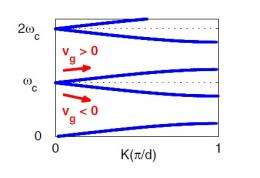May 31, 2011 feature
Physicists describe how to make time-reversed light pulses

(PhysOrg.com) -- By taking advantage of the properties of periodic systems, physicists have described how to efficiently time-reverse ultrashort electromagnetic pulses. Since a time-reversed pulse evolves as if time runs backwards, time reversal eliminates any distortions or scattering that occurred at earlier times, regardless of the medium the pulse has propagated through.
With this advantage, the ability to time-reverse broadband pulses could have applications in medical ultrasound, optical communications, superlensing, ultrafast plasmonics, and biological imaging. Applications could even extend beyond optical implementations, since the scheme does not rely on any concept that is unique to light. This universality opens up possibilities for using time reversal in systems for which it is not currently accessible, such as quantum systems.
The research was performed by Dr. Yonatan Sivan and Professor Sir John Pendry (a pioneer in invisibility cloaks), both of Imperial College London. The scientists have published their study in a recent issue of Physical Review Letters.
So far, time reversal has been successfully demonstrated for pulses of a relatively narrow spectrum. On the other hand, schemes that enable time-reversal of broadband pulses have required complicated techniques, making them difficult to implement and giving them low efficiencies.
The new scheme opens the way to the efficient reversal of truly few-cycle pulses with devices that are easy to fabricate and implement. It is based on dynamically tuning the wave speed in photonic crystals that contain “zero gaps,” which are band gaps with a zero width. As the scientists explain, band gaps are energy or frequency regimes where waves cannot propagate, and are a common characteristic of periodic systems such as photonic crystals. When a band gap has zero width, an incident pulse can propagate through almost perfectly instead of being reflected.
“The zero-gap structure has two features,” Sivan told PhysOrg.com. “First, it serves as an effective homogeneous medium, in the sense that it admits all the incident light; a standard photonic crystal, with a finite gap, would reflect most of the pulse. Second, the existence of two bands at close proximity allows one to transfer energy between them using relatively slow modulations.”
The simplest example of a perfectly symmetric zero-gap system is a one-dimensional photonic crystal with two layers, each exactly a quarter wavelength wide. Such structures are frequently used for anti-reflection coatings. By tuning the wave velocity in the medium in real-time, the researchers calculated that short pulses propagating inside the structure could be reversed with up to 100% efficiency.
“The earliest proposal for using dynamically-tuned photonic crystals for time-reversal was made by Yanik and Fan from Stanford University,” Sivan said. “Their scheme was applied only to pulses of a few tens of picoseconds long and required fairly complicated structures; yet, it served as an inspiration. In that sense, we believe that the greatest significance of our work is to overcome these two limitations – our scheme requires very simple structures and can be applied also to much shorter pulses.”
In the future, the researchers hope to extend and improve this method of time-reversed electromagnetic pulses.
“The continuation of this research involves application of the ideas to other structures, preferably simpler and more efficient,” Sivan said. “Second, we would like to work towards an experimental demonstration of the scheme. Some of these directions are well underway.”
More information: Yonatan Sivan and John B. Pendry. “Time Reversal in Dynamically Tuned Zero-Gap Periodic Systems.” Physical Review Letters 106, 193902 (2011). DOI:10.1103/PhysRevLett.106.193902
Copyright 2011 PhysOrg.com.
All rights reserved. This material may not be published, broadcast, rewritten or redistributed in whole or part without the express written permission of PhysOrg.com.



















